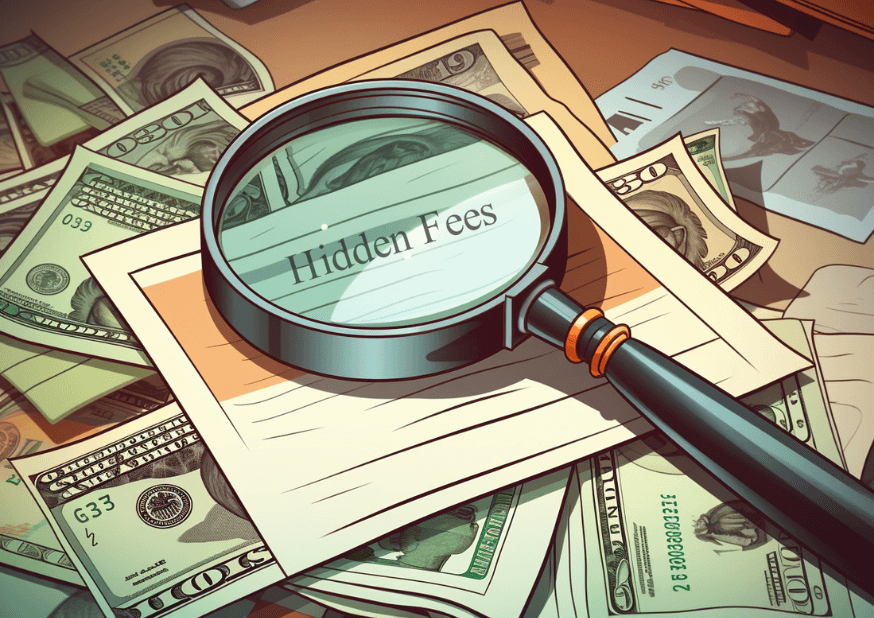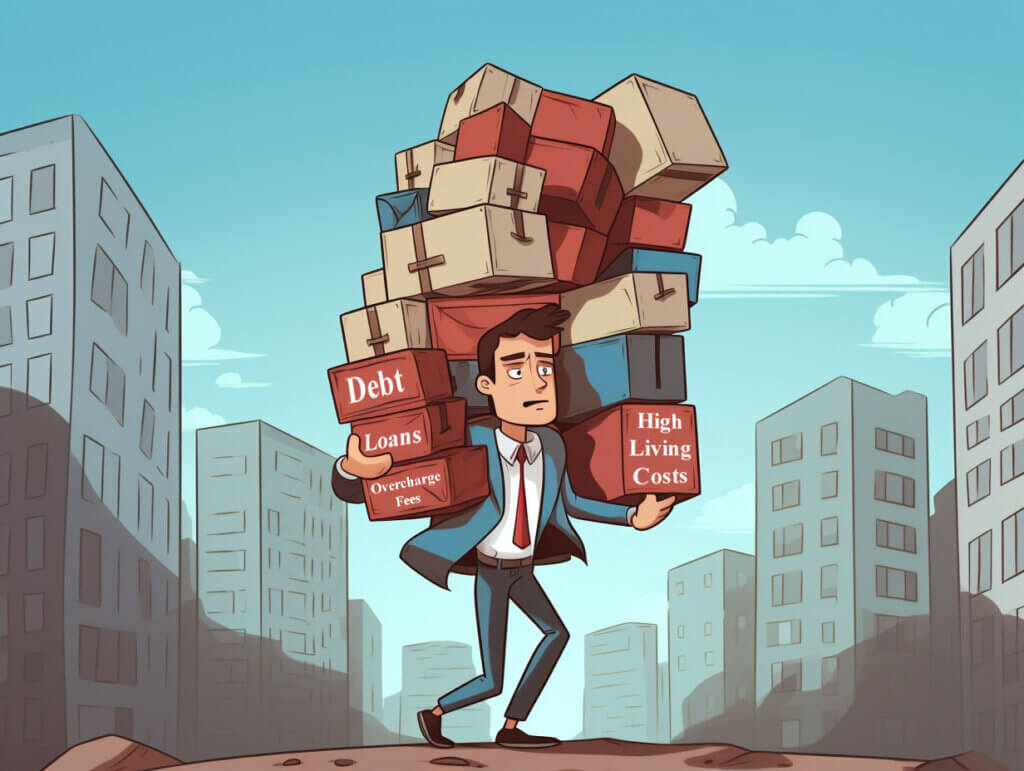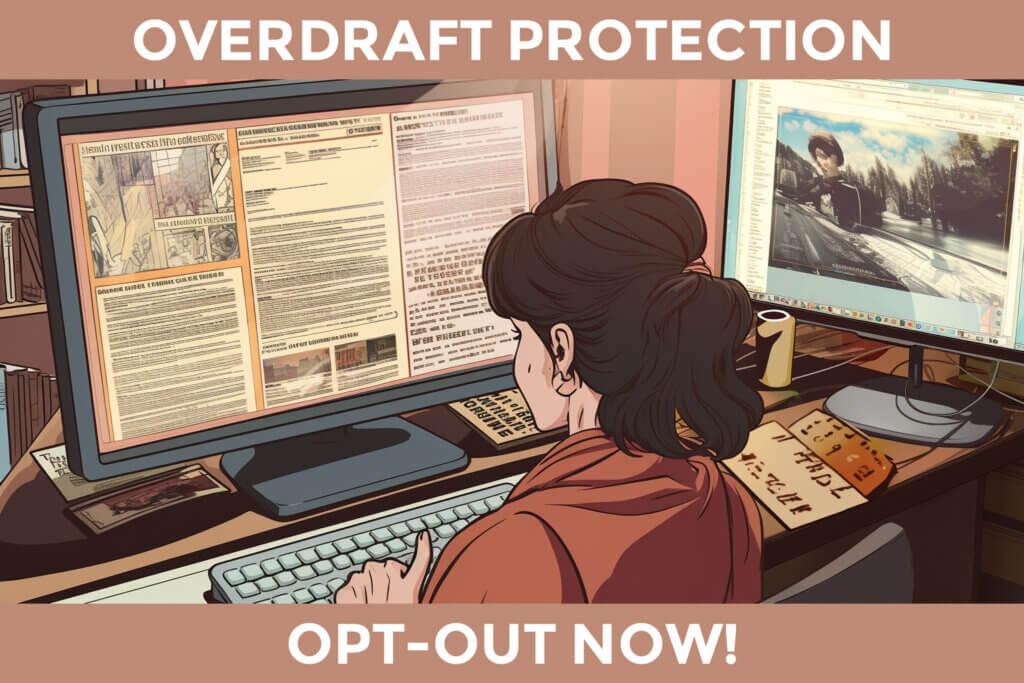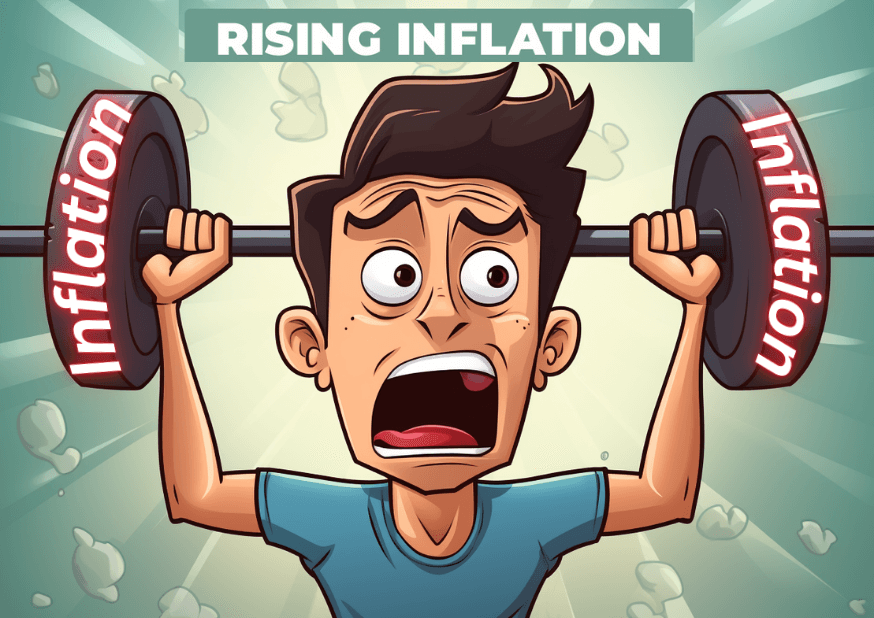- Blogs
- /
- What is Misleading About the Term Overdraft Protection?
What is Misleading About the Term Overdraft Protection?

Summary
Banks allow customers to perform transactions. Even if they don’t have enough money in their accounts, this is called an overdraft.
Although overdraft protection may seem like a lifesaver at first glance. But, there’s a hidden reality that many people fail to recognize its hidden reality.
You see, back in the day, banks allowed customers to overdraw their accounts free of charge. But today, overdraft fees have taken center stage and generated 8 billion for banks in 2022 alone.
But here’s the deceptive part. It can lead to more financial struggles instead of being a protective service.
Thousands of people already suffer from these consequences. Today, we’ll show you what is misleading about the term ‘overdraft protection.’
Key Takeaways
- Overdraft protection allows you to perform transactions even if there isn’t enough money in your account.
- When overdraft protection is enabled on your account, the bank covers any transactions that exceed your available balance.
- Depending on the bank, your overdraft fees may range between $25 and $38. This fee can compound with time.
- Not repaying the negative balance within 90 to 120 days could impact your creditworthiness.
- You can avoid overdrafts by maintaining substantial savings. You can also use budgeting software and set up account alerts.
What is Misleading About the Term Overdraft Protection?
Believe it or not, ‘overdraft protection’ is one of the most misleading terms in personal finance. Even though it sounds helpful, the reality is often quite different.
Let’s take a deeper look at overdraft protection.
Misleading Terminology
First off, the term ‘overdraft protection’ creates false expectations. It implies that this service will protect you from overdrawing your account and incurring fees.
But, overdraft protection allows transactions to go through. It does this even if you don’t have enough money in your account. Yes, this results in hefty fees. The average American spends over $250 yearly on overdraft fees.
This deceptive language can mislead people. It can make them think they are protected from financial difficulties. In fact, they are being subjected to extra charges.
Understanding the misleading term ‘overdraft protection’ is essential to grasp its true nature. Don’t let this misleading term confuse you.
How Overdraft Protection Works
When overdraft protection is enabled on your account, the bank or financial institution will cover any transactions that exceed your available balance.
If you make a purchase or payment that results in insufficient funds, the bank will step in. It will allow the transaction to go through.
But, this so-called ‘protection’ comes at a cost. Each time your account is overdrawn due to overdraft protection, your bank will charge a high fee. The fee can be as high as $38 per transaction.
These fees can add up and strain your finances. This is especially true if your automatic bill payments bounce.
The Reality: No Real Protection
Now that we understand how overdraft protection works, it is crucial to expose the reality behind this facade.
Contrary to popular belief, overdraft protection does not provide any real benefits for consumers. Instead of protecting people from financial hardship, it often worsens their financial struggles.
One common misconception is that overdraft protection is a safety net for emergencies. It is also thought to be for unexpected expenses. But, relying on this service can lead to a cycle of debt and perpetuate poor financial habits.
It’s better to focus on building an emergency fund and managing your finances. Relying on overdraft protection is an illusion.
The Mechanics of Overdraft Protection

Banks often use overdraft protection to make it sound like a helpful service. But, several aspects of this system can be misleading.
Triggering Factors
Understanding what triggers overdraft fees is essential. It helps unravel the complexities of overdraft protection.
If you don’t have enough money in your account for a transaction, most banks will enroll you in their overdraft protection program. It could be when writing a check or using a debit card.
This means that, instead of declining the transaction due to insufficient funds, the bank will allow it to go through. In exchange, they’ll charge you an overdraft fee.
Various factors can lead to triggering overdraft protection. For example, forgetting to record a recent deposit can result in an unintentional overdraft. Miscalculating your balance can, too.
Recurring automatic or scheduled bill payments might coincide with low account balances. This could cause several transactions to trigger overdraft fees.
Everyday situations activate overdraft protection. These include unexpected expenses or emergencies. They cause sudden drops in your account balance.
That’s why it’s essential to be aware of these triggering factors. You can then take proactive measures to avoid unnecessary fees.
Transaction Coverage
Generally, transactions eligible for overdraft protection include ATM withdrawals, debit card purchases, checks written against insufficient funds, and electronic transfers.
But, overdraft protection programs do not cover all transactions. Some banks, like Wells Fargo, may exclude certain types of transactions from coverage.
They may also need customers to opt in for specific categories. For example, ATM withdrawals and debit card purchases.
Ensure you understand the scope of transaction coverage provided by your bank’s overdraft protection program. This ensures that you clearly understand which transactions may incur fees.
Fee Structures
It’s essential you uncover the fee structures associated with overdraft protection. This would help you plan and manage your finances. You see, different banks use various fee models for their overdraft protection programs.
Some banks charge a flat fee between $25 to $38 for each overdraft transaction. Other banks have tiered fee structures. The structures are based on how many times you overdraw your account within a certain period.
Also, if your account stays overdrawn for a long time, banks may charge daily fees. Sadly, these fees can quickly accumulate and significantly burden your finances.
You must familiarize yourself with your bank’s specific fee structure to avoid surprises. Knowing your bank’s fee structure will help you understand what is misleading about the term overdraft protection. This way, you can make informed decisions about your financial transactions.
Overdraft Protection: The Illusion of Safety
There’s an intense need within us to feel secure. And that’s why the term ‘overdraft protection’ can be so appealing. It creates the illusion that we are protected from financial hardships. It also creates the illusion that we are protected from unexpected expenses.
However, several misleading aspects of this term can put us at risk.
1. False Sense of Security
One of the most misleading aspects of overdraft protection is that it can create a false sense of security. When we have overdraft protection on our bank accounts, we may be safe from financial troubles.

Even if we don’t have enough money to cover a purchase or payment, the bank will step in. It will save us from any consequences.
But, relying on overdraft protection as a safety net can be dangerous. It’ll encourage you to spend beyond your means and live paycheck to paycheck. The worst part is that most people don’t consider the long-term consequences of overdrafting.
Instead of building up an emergency fund or practicing responsible budgeting, we depend on the idea that our bank will always bail us out.
2. Hidden Costs
Another misleading aspect of overdraft protection is its hidden costs. While it may seem like a helpful service banks offer, it always comes with extra expenses.
First, many banks charge fees for each transaction exceeding your account balance. And yes, these fees can quickly add up.
These fees are not simple charges; they can have profound financial implications. For example, if you make many transactions while your account is overdrawn, you could pay various fees for each transaction. This can lead to a cycle of debt and further financial strain.
Also, relying on overdraft protection can affect your credit score. This is especially true if it goes to collection.
If you rely on this service and fail to repay the negative balance—within 90 to 120 days—it could impact your creditworthiness. This could make it harder for you to get loans or other forms of credit.
Benefits of Overdraft Protection
Here are some reasons why folks love overdraft protection.
1. It Helps You Avoid Embarrassment
Overdraft protection is one of the best ways to prevent public embarrassment. Imagine you’re at a grocery store, ready to pay for your purchases. Then, you discover you don’t have enough funds in your account to cover the cost.
Trust us, this is a pretty embarrassing situation for anyone. However, with an overdraft protection service in place, the bank will cover the transaction. It will save you from this moment of public embarrassment.
Most people find overdraft protection appealing because it protects them from embarrassment. The psychological aspect of this protection plays a significant role in why most people use overdrafts.
Banks understand that people value their reputation. They want to avoid situations where they appear financially irresponsible. They also want to avoid situations where they seem unable to manage their money.
Banks offer overdraft protection to tap into this fear of embarrassment. They position themselves as saviors who can shield customers from potential shame.
2. It’s an Emergency Buffer
Another advantage of overdraft protection is its role as an emergency buffer. Life is full of unexpected events that can throw our finances off balance. Unforeseen circumstances can strain our budget. It could be a sudden medical expense or a car repair bill.
Overdraft protection provides temporary financial relief. It allows transactions to go through despite insufficient funds in the account.
This means you won’t have to worry about immediate cash flow issues. You won’t have to worry when faced with an emergency expense. Instead, you can rely on your overdraft limit to bridge the gap until you can replenish your funds.
Overdraft protection offers a more affordable and convenient option for managing unexpected expenses.
Disadvantages of Overdraft Protection
Here are some reasons overdraft protection isn’t as beneficial as it seems.
1. It’s got High, Compounding Fees
One of the most significant drawbacks of overdraft protection is the high fees banks charge for this service.
When you overdraw your account, your bank covers the shortfall and charges you a fee. These fees can vary from bank to bank but are substantial when combined.
These exorbitant fees can have a significant impact on customers using overdraft protection. And that’s because, for people who frequently need this service, these fees can quickly add up and burden their finances.
Overdraft protection can worsen financial difficulties due to excessive charges. Instead of providing financial relief, it does the opposite. And having such exorbitant fees contributes to the misleading nature of overdraft protection.
Yes, avoiding declined transactions or bounced checks seems like a safety net. But, it comes at a steep cost. Many customers might not fully comprehend its price until they see their bank statements.
2. It Encourages Overdrafts
Another grey area about overdraft protection is how banks promote it through their policies. Banks often use practices that make it easier for customers to overdraw their accounts without realizing it.
For example, some banks enroll customers in overdraft protection without obtaining explicit consent. They also do not provide clear information about its terms and conditions.
This lack of transparency can lead to unintended consequences. Folks may unknowingly incur overdraft fees when using debit cards. They can also incur these fees when making electronic payments.
Banks inadvertently contribute to frequent overdrawing behaviors among customers by incentivizing overdraft protection. This can create a cycle where individuals rely on this service regularly. They don’t manage their finances more responsibly.
Ultimately, overdraft protection is intended to assist customers. But, it can lead to financial difficulties.
3. Triggers Long-term Financial Consequences
Relying on overdraft protection can have long-term financial consequences. It’s easier to get stuck in a debt cycle because of repeated use of overdraft protection.
Overdraft fees can accumulate over time. This makes it increasingly challenging to regain control of your finances.
Relying too much on overdraft can harm your personal finances. It can stop you from developing good money habits. Instead of learning how to budget and avoid overspending, you can become reliant on overdraft protection as a safety net.
The Impact of Overdraft Protection on Vulnerable Groups

Here’s How Overdraft Protection Affects Millenials and Gen Z
Millennials and Gen Z often face precarious financial situations. This is due to student loans, low wages, and high living costs. Banks see this vulnerability and target millennials with misleading overdraft protection programs.
These programs are designed to make it seem like a safety net for unexpected expenses or emergencies. However, as we’ve discussed, they often come with hidden fees and high-interest rates. This can quickly accumulate debt for millennials who may already be struggling financially.
Also, many Gen Z lack the financial literacy to fully understand the implications of signing up for overdraft protection. They may not even realize that by opting into these programs. They essentially permit banks to charge them exorbitant fees for small overdrafts.
Let’s say your Netflix subscription was renewed for $15.49. However, you only had $10 in your account. Your bank cleared the remaining $5.49 and charged you a $30 overdraft fee, which is much more than your Netflix subscription.
Overdraft fees like this can compound over time. They can lead to a debt cycle that becomes increasingly difficult to break free from.
Here’s How Overdraft Protection Affects Minorities
Minority communities also bear the brunt of misleading overdraft protection practices. Studies have shown that folks from racial and ethnic minority backgrounds are more likely to face financial problems.
Minority households tend to have lower incomes and fewer assets on average. This makes them more vulnerable. As a result, they are disproportionately affected by deceptive banking practices related to overdrafts.
Plus, issues like discriminatory lending practices have historically limited access to affordable credit options for minority communities.
That’s why folks in these communities may be more likely to rely on overdraft protection to cover essential expenses.
Misusing overdraft protection worsens the financial situation faced by minority communities. This could fuel economic inequality.
How to Opt-Out of Overdraft Protection

Customers have the option to opt out of these services. Opting out means you choose not to enroll in deceptive overdraft programs your bank offers. By taking this step, you can avoid unnecessary fees and better manage your finances.
To opt out of misleading overdraft protection, follow these steps:
1. Contact your bank. Contact your bank by phone or in person. Express your desire to opt out of their overdraft protection program. They’ll guide you through the process and provide any necessary forms or information.
2. Fill out the required paperwork. Your bank may require you to complete a form. In the form, you state that you want to opt out of their overdraft protection service. Ensure you provide all the requested information accurately to quicken the process.
3. Confirm the changes. Once you’ve submitted the paperwork, double-check with your bank. Ensure they have processed your request correctly. Confirming that you’re no longer enrolled in overdraft protection is essential.
Four Healthier Alternatives to Overdraft Protection
Opting out of unnecessary and misleading overdraft protection allows you to take control of your finances. Instead of relying on these programs, you can use several better solutions that promote excellent banking habits.
Adopt healthier banking behaviors. Check your account balance regularly and keep track of upcoming expenses. Doing this can end the need for deceptive overdraft programs.
Here’s how:
1. Use Reliable Budgeting Tools
One effective alternative to overdraft protection is using reliable budgeting tools. Examples include Mint, YNAB, SoFi Insights, and the Annual Budget Template on Google Sheets.
These tools can help you track your income and expenses. They allow for better financial management. They also reduce the need for misleading overdraft programs.
Creating a budget and sticking to it can help you gain control over your spending habits. It can also help you avoid overspending in the first place.
Remember, budgeting tools come in various forms. They range from simple spreadsheets to mobile apps. This makes keeping track of your finances more manageable than ever.
2. Create Account Alerts
Many banks offer account alert services. They’ll notify you when certain transactions occur. They’ll also notify you when your balance reaches a specific threshold.
Account alerts are crucial in avoiding unnecessary fees associated with overdraft protection.
These alerts will notify you when your account balance reaches a certain threshold. They will also notify you when specific transactions occur. You can stay informed about your financial situation at all times.
Receiving timely notifications can help you take immediate action to prevent potential overdrafts. You can also adjust your spending habits accordingly. Doing this is one of the best ways to stay proactive. It helps avoid relying on misleading overdraft protection.
3. Maintain a Strong Savings Buffer
Keep a cushion of funds in your account to cover unexpected expenses or emergencies. This will help prevent overdrafts and the need for misleading overdraft protection.
Nothing is better than building a savings cushion. Having an emergency fund or savings buffer provides better financial security. Relying on overdrafts as a safety net does not.
By prioritizing your savings, you can achieve long-term financial stability. Depending on misleading overdraft programs won’t help.
4. Always Check Your Mobile Banking Apps
Mobile banking apps provide convenient access to your account information anytime, anywhere. You can check balances, transfer funds, and track transactions.
Responsible financial practices protect you from deceptive programs and promote long-term financial stability.
A Quick Evaluation of Overdraft Protection
Misleading overdraft protection practices have raised concerns about unfair banking practices. This has led to calls for stricter regulations.
Banks often use deceptive tactics when promoting overdrafts. This has led to ethical concerns and a lack of transparency in their policies.
Unfair Practices and Ethical Concerns
One of the main issues with overdraft protection is the unfair practices associated with it. Many banks use misleading terms like ‘protection.’ They do this to create a false sense of customer security.
In reality, overdraft protection can result in high fees and interest rates. It can financially burden their customers. Banks exploit their customers’ lack of financial knowledge and understanding. They do this by using deceptive language.
The ethical concerns surrounding these practices are significant. Customers may not fully comprehend the consequences of opting into overdraft protection. They may also be unaware that they have other options.
The lack of transparency undermines trust in the banking system. It also contributes to consumer financial inequality.
Advocating for transparency and fairness in banking policies is crucial. This will address unethical practices. Banks should provide clear details about the costs, risks, and alternatives of overdraft protection.
This will empower customers to make informed financial decisions and avoid unnecessary fees.
Regulatory Concerns
The regulatory landscape surrounding misleading overdraft protection practices is another concern. Consumers need stricter regulations to protect them from deceptive banking practices. These practices can lead to financial harm.
Government oversight plays a vital role in curbing misleading overdraft programs. Regulators should enforce rules. The rules should require banks to disclose all overdraft protection fees.
They should ensure banks provide accessible information on alternative options. For example, linking accounts or setting up low-balance alerts.
It’s essential to hold financial institutions accountable for their actions. Calls for stricter regulations are necessary.
Conclusion
So, what’s the deal with ‘overdraft protection’? We’ve deeply explored this financial product and uncovered some eye-opening truths.
Despite its name, overdraft protection can leave you more vulnerable to financial pitfalls. It may seem like a safety net, but it can lead to a cycle of fees and debt that’s hard to escape.
Now that you’re armed with this knowledge, it’s time to take action. Consider exploring alternative options like budgeting tools or setting up low-balance alerts. Take control of your finances. Break free from the illusion of safety that overdraft protection offers.
Remember, your financial well-being is always in your hands. Don’t let misleading terms or products prevent you from achieving your goals.
FAQs
1. What is overdraft protection?
Overdraft protection is a banking service. It allows you to make transactions even if you don’t have enough funds in your account.
It covers the shortfall by lending money. It also transfers funds from another linked account. This helps you avoid declined payments and potential fees.
2. How does overdraft protection work?
When you make a transaction that exceeds your available balance, overdraft protection kicks in. And this is what is misleading about the term overdraft protection.
The bank either lends you the necessary funds. If needed, it transfers money from another linked account to cover the shortfall. This allows your transaction to go through, preventing returned payments and potential fees.
3. What are the advantages of overdraft protection?
Overdraft protection offers convenience. It processes transactions even if your account has insufficient funds.
It helps prevent declined payments and avoids embarrassment. It saves you from potential fees charged by merchants or financial institutions.
4. What are the disadvantages of overdraft protection?
One major disadvantage is that banks often charge high fees for using overdraft protection. It can create a cycle of debt if not managed properly.
You should see overdrafts as short-term solutions. Don’t rely on them long-term because they are costly.
5. Who does overdraft protection impact the most?
Overdraft protection tends to impact vulnerable groups. This includes low-income individuals who may already be struggling with limited financial resources.
These individuals are more likely to incur high fees. They may find themselves trapped in a cycle of debt due to frequent use of this service.
6. Are there alternatives to using overdraft protection?
Yes, there are alternatives worth considering. Building an emergency fund can help cover unexpected expenses without relying on overdrafts.
Setting up low balance alerts can also notify you when your account is running low. This allows you to take immediate action and avoid potential problems.
Our Latest Blogs:

ThisIsJohnWilliams
FREE Strategy Session to Fix Your Credit Blogs / Dealing with financial difficulties is overwhelming. But when faced with...

ThisIsJohnWilliams
FREE Strategy Session to Fix Your Credit Blogs / Facebook Twitter Linkedin Instagram Share Summary Inflation is a complex...

ThisIsJohnWilliams
FREE Strategy Session to Fix Your Credit Blogs / In today’s digitally interconnected world, we all face the danger...

ThisIsJohnWilliams

ThisIsJohnWilliams
FREE Strategy Session to Fix Your Credit Blogs / Facebook Twitter Linkedin Instagram Share Summary Banks allow customers to...





